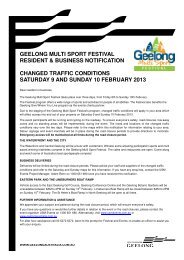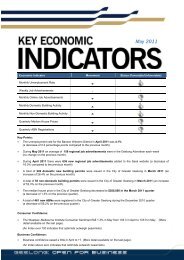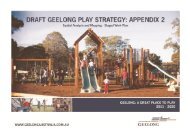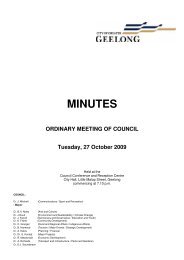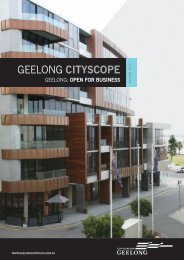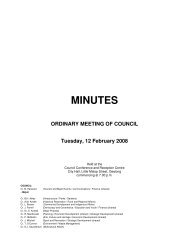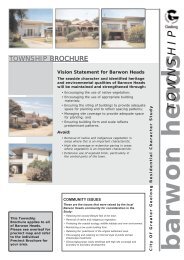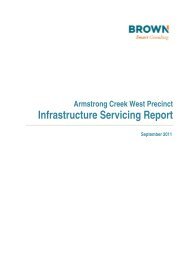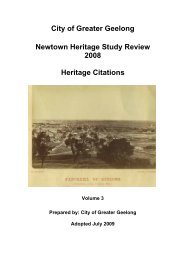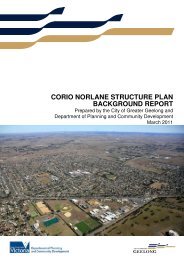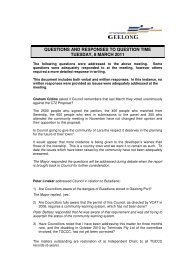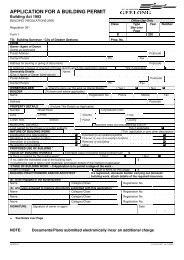armstrong creek urban growth plan volume 1 - City of Greater Geelong
armstrong creek urban growth plan volume 1 - City of Greater Geelong
armstrong creek urban growth plan volume 1 - City of Greater Geelong
Create successful ePaper yourself
Turn your PDF publications into a flip-book with our unique Google optimized e-Paper software.
Housing Mix<br />
In [the traditional New England town], one can live above the store, next to<br />
the store, five minutes from the store or nowhere near the store, and it is<br />
easy to imagine the different age groups and personalities that would prefer<br />
each alternative. In this way and others, the traditional neighbourhood<br />
provides for an array <strong>of</strong> lifestyles. In conventional suburbia, there is only<br />
one available lifestyle: to own a car and to need it for everything. Andres Duany<br />
The detailed housing mix in each neighbourhood will be determined at the next<br />
level <strong>of</strong> <strong>plan</strong>ning for each precinct. However, it is important that the UGP provide<br />
for minimum densities in order to ensure that sufficient population is reached to<br />
support a comprehensive range <strong>of</strong> commercial and community facilities for the<br />
community.<br />
It is also important that the UGP provide for a variety <strong>of</strong> housing types and pricepoints,<br />
in order to provide suitable choices for a range <strong>of</strong> different needs, lifestyle<br />
preferences and income levels. This will ensure that Armstrong Creek attracts a<br />
diverse mix <strong>of</strong> people—<strong>of</strong> varied ages, ethnicity, religion and levels <strong>of</strong> socioeconomic<br />
advantage, in households ranging from single-person to large families—<br />
a hallmark <strong>of</strong> strong communities. It will also avoid the need for people to move<br />
away from their community as their housing needs change.<br />
The Preliminary Housing Analysis undertaken for Armstrong Creek indicates that,<br />
in the period to 2031, the proportion <strong>of</strong> homes that are separate houses is likely to<br />
decrease to between 72 and 82%. It also concludes that the average sized<br />
modern home (assumed to be 228 sqm) can be comfortably accommodated on a<br />
lot <strong>of</strong> 427 sqm, or 256 sqm in a two-level configuration. Further, whilst lot sizes<br />
between 500 and 600 sqm may be the most popular, a trend towards smaller lot<br />
sizes may be emerging, with major property developers now providing lots in the<br />
200-450 sqm range as core product.<br />
It is best practice to mix different forms <strong>of</strong> housing. This avoids the creation <strong>of</strong><br />
single-income-level ‘ghettos’ and promotes healthy interaction between people <strong>of</strong><br />
different socio-economic backgrounds and age. ‘Gated communities’, which<br />
exclude the public from passing through large areas are to be avoided because<br />
they tend to result in homogenous groups <strong>of</strong> residents who do not mix with other<br />
people. They also reduce permeability.<br />
There is a current trend towards smaller lot sizes. This is likely to continue.<br />
Therefore, it will be important that the design <strong>of</strong> lot layouts and controls over their<br />
use do not limit their potential for further subdivision to respond to changing market<br />
preferences.<br />
ARMSTRONG CREEK URBAN GROWTH PLAN / VOLUME 1 (ADOPTED 13 MAY 2008, AMENDED MAY 2010)<br />
70



